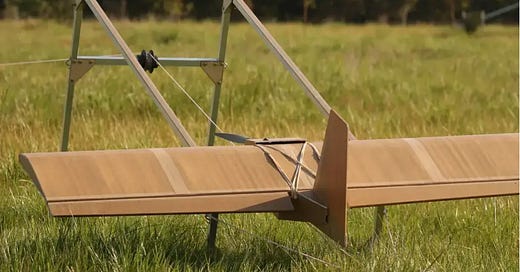OK, take a moment. Look at the above. What do you expect to see off to the sides outside the picture? A bunch of middle school kids from the RC modeling club or a gaggle of junior aerospace engineering students with a project? Giggling a bit at the, “What is that, cardboard and rubber bands?” of it all?
Well, no. What you are looking at is the future imperfect.
Cheap, autonomous, expendable, easily transportable, flexible - and more importantly, decentralized.
The people who have the least time for fools, bad ideas, Tiffany CONOPS, or exquisite theories gummed up by bullsh1t-bingo gobbledygook that takes decades to get to the front like it - the Ukrainians.
The flat-pack design makes it easy to ship the drones, with 24 of them in pizza-size boxes fitting on a pallet. The company could not discuss the price, but it is understood to be a few thousand dollars per unit. Operation is also simple with flight being programmed via a straightforward interface on an Android tablet.
The PPDS flies itself autonomously with no operator control needed. And while it will use GPS guidance where available, if GPS is jammed the control software can work out its position from speed and heading. This means the drone can carry out missions even under conditions of complete radio jamming, which is important in Ukraine where Russian electronic warfare has reportedly taken down large numbers of drones.
…
Why would Ukraine need a small logistics drone? They probably don’t – they seem to have another mission in mind.
“Following feedback from end-users in Ukraine, the system has also been adapted for intelligence, surveillance and reconnaissance missions,” the company state in a press release.
Unlike composites and other “sophisticated” drones whose cost is as great as their production time - the advanced cardboard can be built at scale and transported and assembled with relative ease - in number.
SYPAQ’s most notable product is the Corvo Precision Payload Delivery System (PPDS), a small drone intended for logistics deliveries of payloads up to 5 kilograms (11 lb). The airframe is made of waxed cardboard and the drone is supplied as a self-assembly flatpack, complete with a tablet PC control centre.
The PPDS has a range of up to 120 kilometres (75 mi), and can return and land for re-use. However, its low cost means that it can also be treated as expendable when required. The PPDS has been supplied to Ukraine, whose armed forces have also customised it for other roles.
…
The use of cardboard drones in Ukraine has highlighted the potential of these drones for military applications. The drones are low-cost, easy to assemble, and can be easily modified for different purposes. This makes them ideal for use in low-budget or improvised military environments.
Though they don’t brief well to some in industry where cheap is a threat to their business model and they cannot imagine anything that does not have real time video reachback to DC - with the cardboard drones to the modified jet-ski attack drones at sea, the hints for what we need in future wars is right there in Ukraine if people are willing to act on what they see.
Sadly, too many decision makers seem to be listening to the same usual suspects that WaPo’s David Ignatius talks to. Decision makers need to open their aperture and stop taking the words and perspectives from the same people who have been wrong about the Russo-Ukrainian War from D+0.
Imagine if battalions were issued a flat of these cardboard wonders for use as the battalion commander’s discretion? Heck, give it to the Marines for their next exercise in WESTPAC and see what use they can come up with.
The future imperfect is here.





“Heck, give it to the Marines for their next exercise in WESTPAC and see what use they can come up with.” This instead of DARPA
and here I am, for years offering that modern, fully rigid hulled, amphibious AIRSHIPS (not blimps or dirigible types) can bring enormous advantages to the fleet......cheaply, quick to field. stealthy, survivable, capable.
this brought a smile. I am literally sitting six feet away from materials used to build a living-room sized RC model of my airship........made with foamboard and corrugated plastic sheet.
there is a whole world of non "tech" out there that can be used well, to great advantage. warfare doesn't have to mean umpty-ump hundred million dollar aircraft. A nice little P-51, cheap, slow and dumb as it is............can deliver a super smart missile into range. the missile kills, not the delivery platform, or the pilot, necessarily.